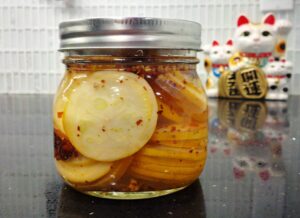
Effectively preserving food could mean the difference between a lean winter and starvation for many humans throughout history. Our persistent ancestors discovered everything from freezing, fermentation, drying, smoking, salting, brining and pickling for preserving meat, fish, grains, produce, eggs and milk.
We still use these age-old preservation techniques today and have added refrigeration, irradiation, preservative chemicals and vacuum sealing to our repertoire.
In all cases these techniques work because they create an environment where the bacteria that cause food to spoil cannot thrive.
Heat, salt, acid are the 3 main ways to stop bacterial growth in pickled foods. Salt and acids (such as vinegar) create a hostile environment that bacteria cannot flourish in. The heat used to sterilize pickling jars, utensils, and lids kills off bacteria on these items.
PIckling uses a combination of salt to aid fermentation and to create an acidic environment bacteria can’t live within, and the addition of an acid, such as vinegar, to enhance the longevity of the foods.. The final stage of pickle production involves boiling the sterilized, filled jars of pickles in a water bath until the food inside the jar, at the centre, reaches 180F (82C). This takes no longer that 15 minutes usually. This is the temperature at which most pathogenic, harmful bacteria are destroyed and the heat inside the jar is sufficient to create an airtight vacuum seal upon cooling, assuming that salt and vinegar are used.
Ironically, we do need some bacteria to create the fermentation process that makes pickles pickled. Only the bacteria needed to create the fermentation and develop the unique pickled flavour survive in the salty, acid pickling brine but are then destroyed with the heat treatment..
Pickled foods can last up to two years in the pantry or fridge.
Brining is just the first step in that pickling process where enough salt is added to water to change its osmotic pressure. As a result of this osmosis, water is drawn out of the food being brined. Brining will help foods last longer, but only for a matter of days or weeks.
Brining when used to preserve vegetables is sometimes called “quick pickling” because the process of making these types of pickles is so fast and because the resulting product doesn’t last as long as true pickles.
Hot, sweet and salty, these quick pickled zucchini slices will last for up to 2 weeks in the fridge and make a pretty hostess gift.
Note – you need to make these slices at least 24 hours before you plan to eat them.
Ingredients
1 zucchini – either green or yellow – washed and sliced into thin coins
2 Tbsp granulated sugar
1 Tbsp salt
1 tsp chili flakes
2 whole pieces star anise
½ cup water
½ cup unseasoned rice vinegar (do not use seasoned rice vinegar – it will over-flavour and salt the brine).
Directions
Put the sliced zucchini into a 2 cup (500 ml) canning jar. Drop in the star anise and the chili flakes.
Mix the sugar, salt, vinegar and water in a cup or jar until the sugar and salt are dissolved. Pour this brine over the slices, seal the jar and store in the fridge. Let the slices sit for at least 24 hours before eating. They will last up to 2 weeks in the fridge.